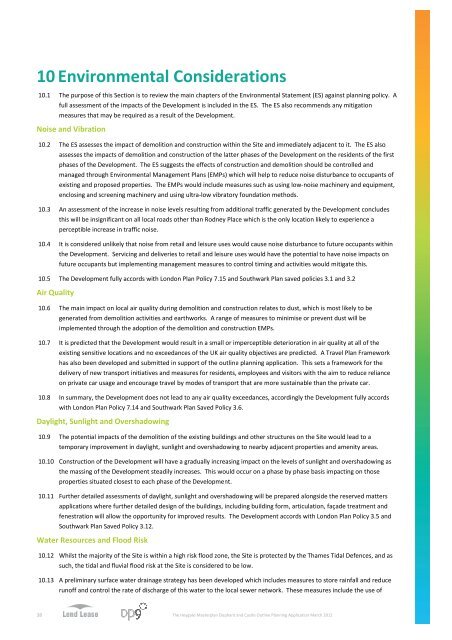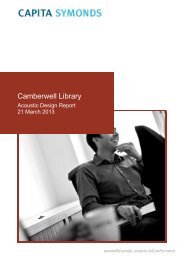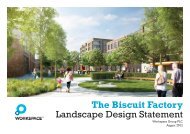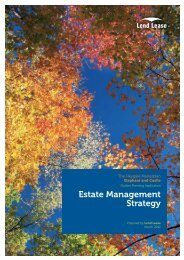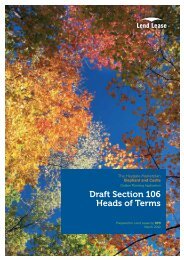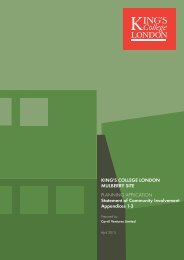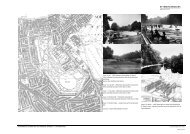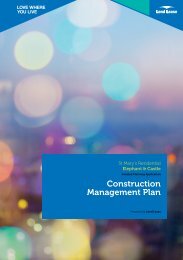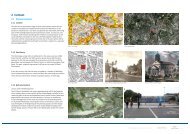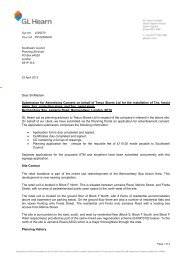Community, Leisure and Cultural Uses (Use Classes D1 and D2)
Community, Leisure and Cultural Uses (Use Classes D1 and D2)
Community, Leisure and Cultural Uses (Use Classes D1 and D2)
You also want an ePaper? Increase the reach of your titles
YUMPU automatically turns print PDFs into web optimized ePapers that Google loves.
10 Environmental Considerations<br />
10.1 The purpose of this Section is to review the main chapters of the Environmental Statement (ES) against planning policy. A<br />
full assessment of the impacts of the Development is included in the ES. The ES also recommends any mitigation<br />
measures that may be required as a result of the Development.<br />
Noise <strong>and</strong> Vibration<br />
10.2 The ES assesses the impact of demolition <strong>and</strong> construction within the Site <strong>and</strong> immediately adjacent to it. The ES also<br />
assesses the impacts of demolition <strong>and</strong> construction of the latter phases of the Development on the residents of the first<br />
phases of the Development. The ES suggests the effects of construction <strong>and</strong> demolition should be controlled <strong>and</strong><br />
managed through Environmental Management Plans (EMPs) which will help to reduce noise disturbance to occupants of<br />
existing <strong>and</strong> proposed properties. The EMPs would include measures such as using low-noise machinery <strong>and</strong> equipment,<br />
enclosing <strong>and</strong> screening machinery <strong>and</strong> using ultra-low vibratory foundation methods.<br />
10.3 An assessment of the increase in noise levels resulting from additional traffic generated by the Development concludes<br />
this will be insignificant on all local roads other than Rodney Place which is the only location likely to experience a<br />
perceptible increase in traffic noise.<br />
10.4 It is considered unlikely that noise from retail <strong>and</strong> leisure uses would cause noise disturbance to future occupants within<br />
the Development. Servicing <strong>and</strong> deliveries to retail <strong>and</strong> leisure uses would have the potential to have noise impacts on<br />
future occupants but implementing management measures to control timing <strong>and</strong> activities would mitigate this.<br />
10.5 The Development fully accords with London Plan Policy 7.15 <strong>and</strong> Southwark Plan saved policies 3.1 <strong>and</strong> 3.2<br />
Air Quality<br />
10.6 The main impact on local air quality during demolition <strong>and</strong> construction relates to dust, which is most likely to be<br />
generated from demolition activities <strong>and</strong> earthworks. A range of measures to minimise or prevent dust will be<br />
implemented through the adoption of the demolition <strong>and</strong> construction EMPs.<br />
10.7 It is predicted that the Development would result in a small or imperceptible deterioration in air quality at all of the<br />
existing sensitive locations <strong>and</strong> no exceedances of the UK air quality objectives are predicted. A Travel Plan Framework<br />
has also been developed <strong>and</strong> submitted in support of the outline planning application. This sets a framework for the<br />
delivery of new transport initiatives <strong>and</strong> measures for residents, employees <strong>and</strong> visitors with the aim to reduce reliance<br />
on private car usage <strong>and</strong> encourage travel by modes of transport that are more sustainable than the private car.<br />
10.8 In summary, the Development does not lead to any air quality exceedances, accordingly the Development fully accords<br />
with London Plan Policy 7.14 <strong>and</strong> Southwark Plan Saved Policy 3.6.<br />
Daylight, Sunlight <strong>and</strong> Overshadowing<br />
10.9 The potential impacts of the demolition of the existing buildings <strong>and</strong> other structures on the Site would lead to a<br />
temporary improvement in daylight, sunlight <strong>and</strong> overshadowing to nearby adjacent properties <strong>and</strong> amenity areas.<br />
10.10 Construction of the Development will have a gradually increasing impact on the levels of sunlight <strong>and</strong> overshadowing as<br />
the massing of the Development steadily increases. This would occur on a phase by phase basis impacting on those<br />
properties situated closest to each phase of the Development.<br />
10.11 Further detailed assessments of daylight, sunlight <strong>and</strong> overshadowing will be prepared alongside the reserved matters<br />
applications where further detailed design of the buildings, including building form, articulation, façade treatment <strong>and</strong><br />
fenestration will allow the opportunity for improved results. The Development accords with London Plan Policy 3.5 <strong>and</strong><br />
Southwark Plan Saved Policy 3.12.<br />
Water Resources <strong>and</strong> Flood Risk<br />
10.12 Whilst the majority of the Site is within a high risk flood zone, the Site is protected by the Thames Tidal Defences, <strong>and</strong> as<br />
such, the tidal <strong>and</strong> fluvial flood risk at the Site is considered to be low.<br />
10.13 A preliminary surface water drainage strategy has been developed which includes measures to store rainfall <strong>and</strong> reduce<br />
runoff <strong>and</strong> control the rate of discharge of this water to the local sewer network. These measures include the use of<br />
38<br />
The Heygate Masterplan Elephant <strong>and</strong> Castle Outline Planning Application March 2012


